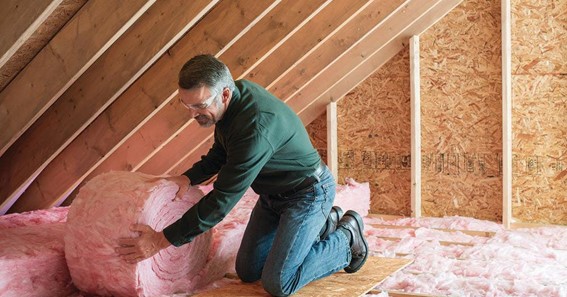The best attic insulation is not a one size fits all answer. Several factors come into play, such as the climate you live in, the size and type of your home, and the material your home is made of. The overriding benefit of attic insulation is better energy efficiency. However, there are several different types of attic insulation, each with its own unique benefits. In this article, you will learn about the different types of attic insulation and how to choose the best one for your home.
Before choosing the best type of attic insulation, you need to understand the R-value as a factor that influences insulation effectiveness.
What Is R-Value?
The R-value of insulation measures its thermal resistance, that is, how well it resists the flow of heat. The higher the R-value, the better the insulation at resisting heat flow. A few factors affect the R-value of insulation, including:
- The type and thickness
- The density
- The climate you live in
Type Of Insulation Material
Now that you understand R-value, let’s look at the different types of attic insulation:
Fiberglass
Fiberglass insulation is one of the most popular insulation materials on the market. It’s cheap and highly accessible, making it a favorite for many homeowners. It’s adept at resisting moisture, meaning it won’t shrink over time. It’s also fire-resistant, and Insects will avoid it. If you’re looking for a quality insulation material that won’t break the bank.
Cellulose
Cellulose insulation is made of recycled paper products. It’s environmentally friendly and is relatively cheaper than fiberglass insulation. However, cellulose insulation is not as moisture resistant as fiberglass, so it’s important to ensure your attic is adequately ventilated. In addition, Cellulose insulation sags over time, so it’s important to install a sufficient amount to avoid any cold spots.
Spray Foam
Spray foam insulation is a newer type of insulation made of polyurethane. It’s a good choice if you want to seal up any air leaks in your attic, as it expands and fills in any cracks or crevices. It is also impervious to water, meaning it will not absorb moisture like other insulation types.
Having spray foam insulation assures you of durable, long-term insulation as it will not sag, shrink or lose its R-value over time. You’ll also benefit from soundproofing your home from outside noise.
However, spray foam insulation can be expensive and cause problems if not installed correctly.
For instance, exposure to spray foam before it fully cures can cause skin and eye irritation.
While fiberglass and cellulose are the most popular types of insulation, you may want to consider spray foam if you are looking for the best insulation for your home.
Mineral Wool
Mineral wool insulation is made of recycled glass or rock mineral fiber. It’s a good choice if you live in a cold climate, as it has a high R-value. Some of the benefits of mineral wool include
Its resistance to fire – MineraI wool does not ignite, smolder or support combustion.
Soundproofing: Mineral wool is an effective sound absorber, which can help to muffle noise from outside and inside your home.
Water-resistance: Mineral wool is water-resistant and will not absorb moisture like other insulation types.
It’s important to note that mineral wool insulation can potentially cause cancer, so it’s important to wear a mask and gloves when installing it.
Now that you know about the different types of insulation material, let’s look at the common methods of installing insulation:
Batt Or Blanket Insulation
Batt or blanket insulation is a type of insulation that comes in rolls or panels. It’s typically made of fiberglass or mineral wool and is installed in between the joists in your attic. Batt insulation is easy to install and popular for homeowners with expansive attics.
Blown-In Insulation
Blown-in insulation is another type of insulation that is installed in your attic. It’s fiberglass, cellulose, or mineral wool and is blown into the space between the joists with a particular machine.
This type of insulation is a good choice if you have an attic with limited access, as the machine can easily reach tight spaces.
Spray Foam Insulation
Spray foam insulation is installed by spraying it into the cracks and crevices of your attic. It expands and fills gaps, creating a seal that prevents air and moisture from entering.
This type of insulation is an excellent choice to stop any air leaks in your attic. It is also water-resistant and will not absorb moisture like some other types of insulation.
When choosing insulation for your home, it’s important to consider all the available types. Each type of insulation has its benefits and drawbacks, so you’ll want to choose the one that best suits your needs. Spray foam insulation is good if you’re looking for durable, long-term insulation that will not sag or lose its R-value over time. However, if you are concerned about potential health risks, cellulose insulation may be better. No matter which type of insulation you choose, make sure to have it installed by a professional to ensure a proper installation.






